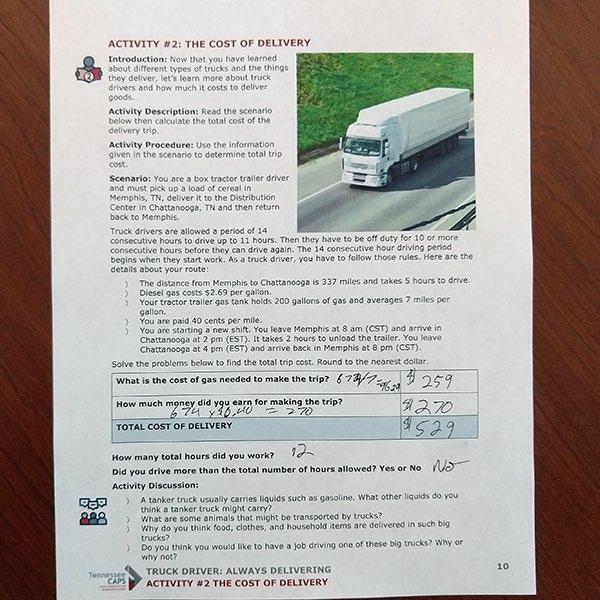TRUCK DRIVER: ALWAYS DELIVERING



LESSON PLAN OVERVIEW
Career: Truck drivers deliver goods and materials to and from manufacturers and suppliers to stores, companies, and other customers
Lesson: This lesson plan provides activities for students to learn about truck drivers and what they do. Students will learn about the different types of tractor trailers and some of the goods they carry. Students will also read a scenario about a delivery and calculate the overall cost of making the delivery
Grade Level: Elementary Grades
Learning Objectives:
〉 Students will be introduced to the career of truck driving and learn about what truck drivers do.
〉 Students will learn about the different types of tractor trailers and the goods they carry.
〉 Students will learn about the costs associated with making deliveries and will calculate the cost of making a delivery.
Materials Needed:

Activity #1: Tractor Trailers – What Do They Carry?
〉 Student worksheet
Activity #2: The Cost of Delivery
〉 Student worksheet 〉 Calculator

TEACHER GUIDE
Lesson Instructions: The following activities will help you introduce students to the truck driver career and some of their job tasks. Begin the lesson by reading the Class Message below to your students, then have them watch the recommended career video. Afterwards, facilitate a discussion using the Class Questions listed below.
After the discussion, students will work on two activities. Each activity has a printable worksheet with student instructions and areas to record their work. Have students read their worksheets before beginning each activity.
You should also familiarize yourself with the student worksheets to provide assistance when needed, help demonstrate any procedures, and help in facilitating the discussion that ends each activity.


Class Message: Today, we are going to learn about truck drivers. How many of you have seen large trucks driving down the road? Have you ever wondered what these big trucks are carrying? Truck drivers carry and deliver practically everything - our food, the clothes we wear, the toys you play with, and all of the things we have in this classroom, including this pencil! Without truck drivers, we would have a hard time getting the everyday things we need to live.
In this lesson, we will learn about some of the different types of tractor trailers and the things they carry. We’ll also learn about how much it costs truck drivers to make deliveries. You will read information about a delivery route and calculate how much the delivery would cost the trucking company.
Let’s watch this short video to learn more about truck drivers.



Class Discussion Questions:
〉 What are some of the things you use every day? - Response Suggestions: cell phone, computer, bookbag, clothes, shoes, etc.
〉 Where do you think everything you use comes from? - Response Suggestions: a store, ordered online, etc.
〉 How do you think those items got to the store? - Response Suggestions: delivery person, on a truck, delivered by a truck, etc.
〉 What are some different kinds of trucks you have seen? - Response Suggestions: delivery truck (Amazon, Walmart, UPS, FedEx), food trucks (grocery store), etc.
Activities Overview: This lesson plan includes two student activities. Activity #1 challenges students to identify different tractor trailers and what they carry. In Activity #2, students will learn about the costs associated with truck driving and calculate the cost of making a delivery.
Read and familiarize yourself with the student worksheet for each activity.

Activity #1: Tractor Trailers – What Do They Carry?
Students will learn about the types of tractor trailers and the goods they transport. Students will then complete a Word Search Puzzle by answering questions using the information provided in the passage.
Activity Instructions:
〉 Hand out the student worksheet.
〉 Introduce the activity and guide students as needed.
〉 Optional – give students the word list to use in the word search puzzle.
〉 After completion, facilitate a discussion using the questions for the activity.
Activity Results: This activity introduced students to the truck driving career and the types of tractor trailers they drive and products they deliver. Students completed a word search puzzle using the information contained in the passage.
Word List:


Activity Discussion:
〉 Have you seen any of these types of trucks? If so, where? - Allow students to share their experience.
〉 Did the truck have a picture on the side to give you a clue to what they carry?Allow students to share their experience.

〉 What is the strangest thing you have ever seen being transported by a truck?Allow students to share their experience.
〉 What are some of the largest things you’ve ever seen a truck carrying? - Allow students to share their experience.

Activity #2: The Cost of Delivery
Students will learn about the costs associated with truck driving and will calculate the cost of a delivery.
Activity Instructions:
〉 Hand out the student worksheet.
〉 Introduce the activity and guide students as needed.
〉 After completion, facilitate a discussion using the questions for the activity
Activity Results: Students learned about the costs associated with truck driving. They used information about a delivery and calculated the delivery cost.
Scenario: Pretend you are a box tractor trailer driver who must pick up a load of cereal in Memphis, TN, deliver it to the Distribution Center in Chattanooga, TN and then drive back to Memphis.

Truck drivers are allowed a period of 14 consecutive hours to drive up to 11 hours. Then they have to be off duty for 10 or more consecutive hours before they can drive again. The 14 consecutive hour driving period begins when they start work. As a truck driver, you have to follow those rules. Here are the details about your route:
〉 The distance from Memphis to Chattanooga is 337 miles and takes 5 hours to drive.
〉 Diesel gas costs $2.69 per gallon.
〉 Your tractor-trailer gas tank holds 200 gallons of gas and averages 7 miles per gallon.
〉 You are paid 40 cents per mile.
〉 You are starting a new shift. You leave Memphis at 8 am (CST) and arrive in Chattanooga at 2 pm (EST). It takes 2 hours to unload the trailer. You leave Chattanooga at 4 pm (EST) and arrive back in Memphis at 8 pm (CST).
Solve the problems below to find the total trip cost. Round to the nearest dollar.
What is the cost of gas needed to make the trip?
674 miles/7 mpg = 96.29 X $2.69 per gallon = $259 (rounded)
How much money did you earn for making the trip?
674 miles X $.40 per mile = $270 (rounded) $270 TOTAL COST OF DELIVERY
How many total hours did you work? 12
Did you drive more than the total number of hours allowed? Yes or No


Activity Discussion:
〉 Did you have trouble solving this problem? If so, why? - Allow students to share their experience.
〉 What are some other costs that truck drivers or trucking companies might have with tractor trailers? - Sample answers may include: the cost of the truck or monthly payment on the truck, repairs and maintenance, insurance, etc.
〉 What are some problems a driver might have that would delay the delivery time of a load? - Sample answers may include: mechanical breakdown, flat tire, accidents on the highway, high level of traffic, road construction, weigh station backup, bad weather, etc.
CAREER INSIGHT

Career Highlight: This lesson plan highlights some of the duties of a truck drive. See the Employers in My Area section to contact businesses and organizations in your area about classroom demonstrations, onsite visits, or other additional career exposure opportunities.
Featured Career:
Truck Driver
Career Descriptions: Heavy and tractor trailer truck drivers transport goods from one location to another. Most tractor trailer drivers are long-haul drivers and operate trucks with a total weight exceeding 26,000 pounds for the vehicle, passengers, and cargo. These drivers deliver goods over intercity routes that sometimes span several states.

Heavy and tractor trailer truck drivers typically do the following:
〉 Drive long distances
〉 Report any incidents encountered on the road to a dispatcher
〉 Follow all applicable traffic laws
〉 Secure cargo for transport, using ropes, blocks, chains, or covers
〉 Inspect their trailers before and after the trip and record any defects they find
〉 Maintain a log of their working hours, following all federal and state regulations
〉 Report serious mechanical problems to the appropriate people
〉 Keep their trucks and associated equipment clean and in good working order
Most heavy and tractor trailer truck drivers’ routes are assigned by a dispatcher, but some independent drivers still plan their own routes. Drivers also must plan legally-required rest periods into their trip.
Some drivers have one or two routes that they drive regularly, and other drivers take many different routes throughout the country. In addition, some drivers have routes that include Mexico or Canada.
Certain cargo requires drivers to adhere to additional safety regulations. Other drivers, such as those carrying liquids, oversized loads, or cars, must follow rules that apply specifically to them.
Other Names for this Career: Truck Driver, Delivery Driver, Line Haul Driver, Tractor Trailer Operator, Driver, Semi Truck Driver, Road Driver, Production Truck Driver, Over the Road Driver (OTR Driver), Log Truck Driver








